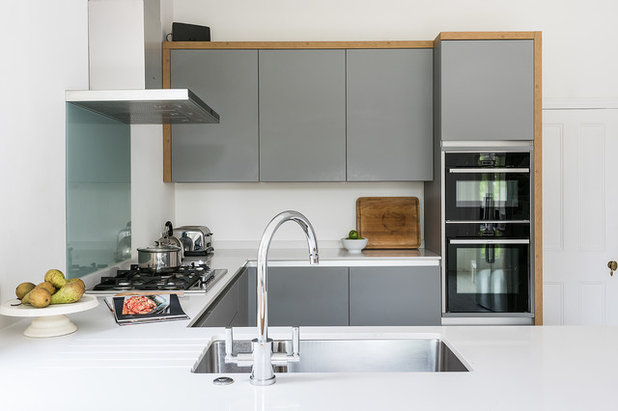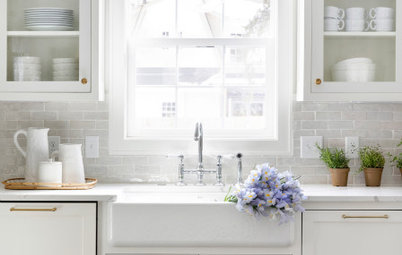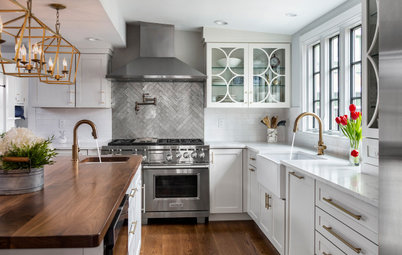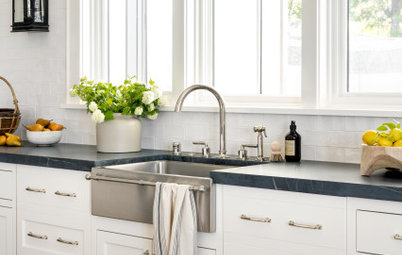Which Type of Kitchen Sink Should You Choose?
Learn the pros and cons of common kitchen sink styles and materials
Amanda Pollard
December 3, 2019
Senior Editor at Houzz UK and Ireland. Journalist and editor specialising in interiors and architecture.
Senior Editor at Houzz UK and Ireland. Journalist and editor specialising in interiors... More
There are many types of kitchen sinks to choose from. Review this guide outlining the pros and cons of each mounting style and material to find the best sink for your kitchen.
Which Sink Style Should You Choose?
There are three main sink types in terms of installation: undermount, top mount and integrated. Here’s a rundown of the options.
Undermount
For a sleek look, go for an undermount design. These sinks are installed below the countertop, with the rim concealed so no edges show.
Pros: With no exposed rim to trap food, an undermount sink is a great option if you want something that’s easy to clean. It doesn’t take up space on the countertop, and it has a streamlined, minimalist aesthetic.
Cons: As this type of sink usually hangs below the countertop, you’ll need a surface that’s strong and water-resistant — if your countertop is laminate, it might not support the weight. It’s also important to hire a professional installer who can ensure your sink is well-supported and doesn’t leak.
Find a kitchen remodeler
There are three main sink types in terms of installation: undermount, top mount and integrated. Here’s a rundown of the options.
Undermount
For a sleek look, go for an undermount design. These sinks are installed below the countertop, with the rim concealed so no edges show.
Pros: With no exposed rim to trap food, an undermount sink is a great option if you want something that’s easy to clean. It doesn’t take up space on the countertop, and it has a streamlined, minimalist aesthetic.
Cons: As this type of sink usually hangs below the countertop, you’ll need a surface that’s strong and water-resistant — if your countertop is laminate, it might not support the weight. It’s also important to hire a professional installer who can ensure your sink is well-supported and doesn’t leak.
Find a kitchen remodeler
Top-Mount
A popular choice of kitchen sink is the top-mount, or drop-in, model. The basin is inserted into a precut hole in the countertop, with the edges showing above the surface.
Pros: A top-mount sink is usually cheaper than an undermount one and simpler to install. Your choice of countertop won’t be limited, either, as it works with any type of surface.
Cons: The most obvious disadvantage of this type of sink is the exposed edge, where food and debris can get trapped. A good installer will seal the edges well to ensure they’re watertight.
Shop for kitchen sinks on Houzz
A popular choice of kitchen sink is the top-mount, or drop-in, model. The basin is inserted into a precut hole in the countertop, with the edges showing above the surface.
Pros: A top-mount sink is usually cheaper than an undermount one and simpler to install. Your choice of countertop won’t be limited, either, as it works with any type of surface.
Cons: The most obvious disadvantage of this type of sink is the exposed edge, where food and debris can get trapped. A good installer will seal the edges well to ensure they’re watertight.
Shop for kitchen sinks on Houzz
Integrated
It’s possible to create a seamless transition between sink and countertop by going for an integrated sink made of the same material as your countertop. The Corian countertop in this kitchen has been molded to incorporate a simple square sink.
Pros: The seamless design of an integrated sink makes it easy to keep clean, as there are no seams where dirt can get trapped. It will also give your kitchen a smooth, luxurious look.
Cons: The work involved in creating an integrated sink makes it more expensive than some other designs. Also, as it’s attached, any damage to the sink might result in having to replace the whole countertop.
How to Configure Your Kitchen Sink
It’s possible to create a seamless transition between sink and countertop by going for an integrated sink made of the same material as your countertop. The Corian countertop in this kitchen has been molded to incorporate a simple square sink.
Pros: The seamless design of an integrated sink makes it easy to keep clean, as there are no seams where dirt can get trapped. It will also give your kitchen a smooth, luxurious look.
Cons: The work involved in creating an integrated sink makes it more expensive than some other designs. Also, as it’s attached, any damage to the sink might result in having to replace the whole countertop.
How to Configure Your Kitchen Sink
Which Sink Material Is Best?
The material you choose for your sink will depend on the style of your kitchen and the practicality of each surface for your needs.
Ceramic
If your style is more traditional than modern, you could go for a ceramic sink in a farmhouse design. The undermounted model pictured here sits above a short cabinet and goes well with the Shaker-style kitchen.
Pros: These types of sink are elegant, timeless and hard-wearing, and can be a design feature in themselves. They’re also great if you have large pots and pans to clean, as the basin is generally quite deep.
Cons: Ceramic sinks are heavy to install, and if you’re going for an open-front option like the one here, you’ll need to design your cabinetry around it. And if you choose white, the sink will also need cleaning frequently, as it will show stains more than most other materials.
The material you choose for your sink will depend on the style of your kitchen and the practicality of each surface for your needs.
Ceramic
If your style is more traditional than modern, you could go for a ceramic sink in a farmhouse design. The undermounted model pictured here sits above a short cabinet and goes well with the Shaker-style kitchen.
Pros: These types of sink are elegant, timeless and hard-wearing, and can be a design feature in themselves. They’re also great if you have large pots and pans to clean, as the basin is generally quite deep.
Cons: Ceramic sinks are heavy to install, and if you’re going for an open-front option like the one here, you’ll need to design your cabinetry around it. And if you choose white, the sink will also need cleaning frequently, as it will show stains more than most other materials.
Contemporary farmhouse sinks come in double-basin versions too. This top-mounted model is wide and shallow, with two equal sections. Unlike a traditional design, in which the faucet is fitted into the countertop, this one has a ridged area for the tap to be inserted into.
Stainless Steel
Versatile and durable, stainless steel sinks have been popular in kitchens for decades. They’re available in most styles, and the color goes with pretty much any cabinetry.
Pros: Stainless steel sinks are affordable and easy to install. They’re also incredibly durable, so unless you get bored of the design, your sink should last forever.
Cons: Although it’s hard-wearing, stainless steel is susceptible to scratches, so avoid using abrasive cleaners. And if you want a gleaming surface without water stains, you’ll have to wipe your sink dry every time after cleaning.
Versatile and durable, stainless steel sinks have been popular in kitchens for decades. They’re available in most styles, and the color goes with pretty much any cabinetry.
Pros: Stainless steel sinks are affordable and easy to install. They’re also incredibly durable, so unless you get bored of the design, your sink should last forever.
Cons: Although it’s hard-wearing, stainless steel is susceptible to scratches, so avoid using abrasive cleaners. And if you want a gleaming surface without water stains, you’ll have to wipe your sink dry every time after cleaning.
You don’t have to go for a standard stainless steel sink design. The farmhouse option seen here is a contemporary update on the traditional ceramic version.
Composite
Some modern sinks are made from a composite of granite and acrylic resin, and formed under a high compression to make them extremely durable and scratch-resistant.
Pros: Composite sinks are nonporous, heat-resistant and hygienic. They’re available in a number of styles and finishes, and bring a uniform look to a contemporary kitchen.
Cons: The hard surface of composite sinks is great for durability, but not so useful if you drop glassware on it. Also, if you’re looking for a natural material that forms a patina over time, a composite sink might not be the right choice for you.
Some modern sinks are made from a composite of granite and acrylic resin, and formed under a high compression to make them extremely durable and scratch-resistant.
Pros: Composite sinks are nonporous, heat-resistant and hygienic. They’re available in a number of styles and finishes, and bring a uniform look to a contemporary kitchen.
Cons: The hard surface of composite sinks is great for durability, but not so useful if you drop glassware on it. Also, if you’re looking for a natural material that forms a patina over time, a composite sink might not be the right choice for you.
Copper
To make a design statement in your kitchen, consider a more unusual sink material, such as copper. This farmhouse design looks stunning alongside the mellow green cabinets.
Pros: Copper is naturally antibacterial, so it’s a hygienic option. It’s durable and easy to clean, as long as you know which substances to avoid.
Cons: Maintenance is simple, but certain substances will cause damage — avoid acidic foods and harsh chemicals, as well as hot pans and utensils. Copper isn’t the cheapest material to use, so it’s not a good choice if you’re on a budget.
To make a design statement in your kitchen, consider a more unusual sink material, such as copper. This farmhouse design looks stunning alongside the mellow green cabinets.
Pros: Copper is naturally antibacterial, so it’s a hygienic option. It’s durable and easy to clean, as long as you know which substances to avoid.
Cons: Maintenance is simple, but certain substances will cause damage — avoid acidic foods and harsh chemicals, as well as hot pans and utensils. Copper isn’t the cheapest material to use, so it’s not a good choice if you’re on a budget.
For added durability and less chance of visible stains, go for hammered copper rather than a smooth finish. The circular hammered-copper sink seen here contrasts beautifully with the veined white countertop.
Tell us: Which style and material would you prefer in your kitchen? Share your thoughts and tips in the Comments.
More on Houzz
Read more stories on kitchen design
Find a kitchen designer near you
Shop for kitchen products
Tell us: Which style and material would you prefer in your kitchen? Share your thoughts and tips in the Comments.
More on Houzz
Read more stories on kitchen design
Find a kitchen designer near you
Shop for kitchen products
Related Stories
Kitchen Storage
Get the Most Out of Your Kitchen’s Undersink Area
Clever solutions can turn this awkward space into a storage workhorse for cleaning supplies and more
Full Story
Remodeling Guides
6 Things to Consider When Choosing a Kitchen Sink
By Jennifer Ott
Use this guide to help you think about sink size, bowl depth, location and other factors
Full Story
Kitchen Design
Where Should You Put the Kitchen Sink?
By Jennifer Ott
Facing a window or your guests? In a corner or near the dishwasher? Here’s how to find the right location for your sink
Full Story
Kitchen Design
How to Choose a Kitchen Sink Size
By Jennifer Ott
Bigger isn’t necessarily better. Here’s how to pick the right size sink for your kitchen, needs and budget
Full Story
Kitchen Design
How to Keep Your Kitchen Sink Looking Great
By Erin Carlyle
Learn the care regimen for 10 popular kitchen sink materials, including stainless steel, copper and granite composite
Full Story
Kitchen Design
How to Choose the Right Depth for Your Kitchen Sink
By Jennifer Ott
Avoid an achy back, a sore neck and messy countertops with a sink depth that works for you
Full Story
Kitchen Design
How to Choose the Best Sink Type for Your Kitchen
By Jennifer Ott
Drop-in, undermount, integral or apron-front — a design pro lays out your sink options
Full Story
Kitchen Design
8 Ways to Configure Your Kitchen Sink
By Jennifer Ott
One sink or two? Single bowl or double? Determine which setup works best for you
Full Story
Kitchen Design
8 Kitchen Sink Materials to Consider
By Jennifer Ott
Learn the pros and cons of these common choices for kitchen sinks
Full Story
Kitchen Design
Where to Put Your Sink and Cooktop
By Kate Burt
These two key kitchen elements will determine your layout. Designers tell how to get their locations right
Full Story















































Thank you @ Deborah Eade, I think you may have suggested my favoured option - certainly in terms of cost and aesthetics. I guess I just feel guilty about rejecting what to many is a considered a 'better' product. Anyone want a secondhand brown composite double sink and drainer?!!
@ Freddi, if you can sell it on the equivalent of Le Bon Coin (I live in France), that might well pay for your forever stainless steel sink!
Sounds like a plan @ Deborah Eade!